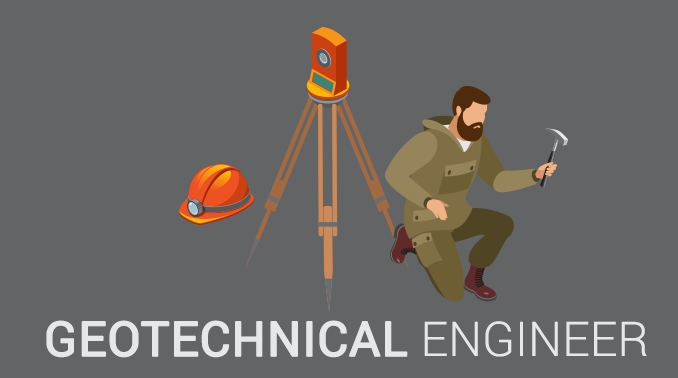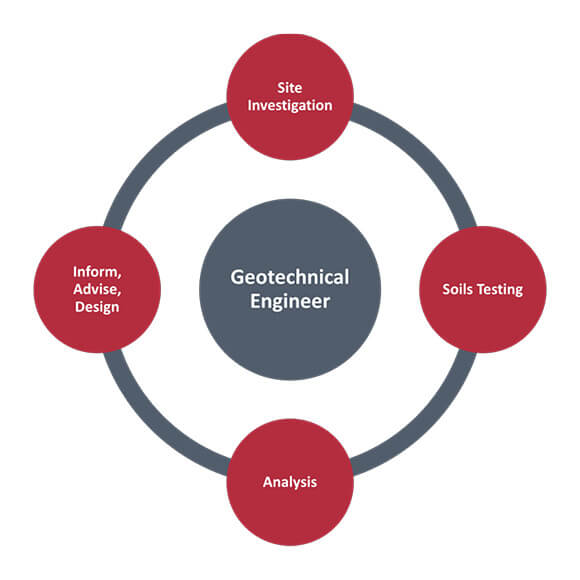The Single Strategy To Use For Geotheta
Table of Contents7 Simple Techniques For GeothetaSome Of GeothetaA Biased View of GeothetaThe Ultimate Guide To GeothetaThe 3-Minute Rule for Geotheta

They perform site investigations, collect examples, execute laboratory tests, and examine information to review the suitability of the ground for building and construction tasks - Geo Tech Engineering. Based on their findings, geotechnical engineers give recommendations for foundation style, incline stability, keeping frameworks, and reduction of geotechnical threats. They team up with various other professionals, such as architects, architectural engineers, and building groups, to ensure that geotechnical considerations are incorporated right into the overall task design and implementation
By analyzing the behavior and residential properties of dirt and rock, they can identify possible geotechnical risks such as landslides, soil negotiation, or slope instability. Their competence assists protect against failings or mishaps that might jeopardize lives and home. Below are some thorough responsibilities and duties of a geotechnical designer: Website Investigation: Geotechnical designers conduct site examinations to collect data on subsurface problems.
They translate the data to recognize the buildings and habits of the dirt and rock, including their strength, permeability, compaction characteristics, and groundwater problems. Geotechnical Analysis and Design: Geotechnical designers analyze the information accumulated throughout site investigations to assess the security and suitability of the site for building projects. They execute geotechnical computations and modeling to examine factors such as bearing capacity, negotiation, incline security, side earth stress, and groundwater circulation.
The Ultimate Guide To Geotheta
Foundation Style: Geotechnical designers play a crucial role in making foundations that can securely support the desired framework. They assess the dirt problems and lots demands to determine the ideal structure kind, such as shallow foundations (e.g., grounds), deep structures (e.g (https://experiment.com/users/geotheta)., stacks), or specialized methods like dirt renovation. They take into consideration factors such as negotiation limits, birthing ability, and soil-structure interaction to create optimal structure layouts
They review building plans, monitor website activities, and carry out area inspections to confirm that the design referrals are followed. If unanticipated geotechnical issues develop, they examine the circumstance and offer recommendations for removal or changes to the style. Threat Assessment and Mitigation: Geotechnical designers evaluate geotechnical hazards and dangers related to the project site, such as landslides, liquefaction, or dirt erosion.

Partnership and Communication: Geotechnical designers function carefully with various other professionals associated with a project, such as designers, architectural engineers, and construction teams. Effective interaction and partnership are important to incorporate geotechnical considerations into the overall project style and construction procedure. Geotechnical engineers supply technological experience, answer inquiries, and make sure that geotechnical needs are satisfied.
What Does Geotheta Mean?
Right here are some sorts of geotechnical designers: Structure Designer: Structure designers focus on creating and analyzing structures for structures. They analyze the soil problems, tons demands, and site characteristics to identify the most ideal structure type and design, such as shallow structures, deep foundations, or specialized methods like pile foundations.
They review the variables affecting slope security, such as soil homes, groundwater conditions, and slope geometry, and develop strategies to avoid slope failings and minimize dangers. Earthquake Engineer: Earthquake designers focus on assessing and creating structures to endure seismic pressures. They analyze the seismic risk of a site, assess dirt liquefaction capacity, and establish seismic design standards to make sure the security and resilience of structures throughout earthquakes.
They perform field screening, collect samples, and assess the accumulated data to define the soil residential or commercial properties, geologic developments, and groundwater problems at a site. Geotechnical Instrumentation Engineer: Geotechnical instrumentation engineers concentrate on surveillance and determining the behavior of soil, rock, and frameworks. They install and preserve instrumentation systems that keep track of elements such as dirt negotiation, groundwater degrees, slope activities, and structural displacements to analyze performance and offer early cautions of prospective concerns.
Fascination About Geotheta
They carry out tests such as triaxial examinations, loan consolidation tests, direct shear tests, and leaks in the structure tests to collect data for geotechnical evaluation and design. Geosynthetics Engineer: Geosynthetics engineers specialize in the layout and application of geosynthetic materials, such as geotextiles, geogrids, and geomembranes. They utilize these products to improve soil stability, reinforce slopes, supply water drainage solutions, and control erosion.
They often tend to be investigative people, which means they're intellectual, introspective, and inquisitive. They wonder, methodical, sensible, analytical, and sensible. Some of them are also social, indicating they're kind, generous, participating, patient, caring, practical, empathetic, tactful, and friendly. Does this seem like you? Take our totally free occupation examination to discover if geotechnical designer is one of your top profession suits.
In the workplace setting, geotechnical engineers utilize specialized software application devices to execute computations, create styles, and analyze information. They prepare records, testimonial project requirements, connect with customers and staff member, and coordinate project activities. The workplace setting supplies a helpful setting for research study, analysis, and partnership with various other professionals involved in the task.
Facts About Geotheta Revealed
They regularly visit job sites to perform site examinations, evaluate geotechnical conditions, and gather data for evaluation. These sees involve taking a trip to various areas, often in remote or tough terrains. Geotechnical designers may perform dirt tasting, conduct tests, and screen construction activities to make sure that the geotechnical elements of the job are being carried out correctly.
Geotechnical engineers also work in specialized geotechnical labs. Geotechnical lab designers function thoroughly in these environments, managing screening devices, running tools, and videotaping information.